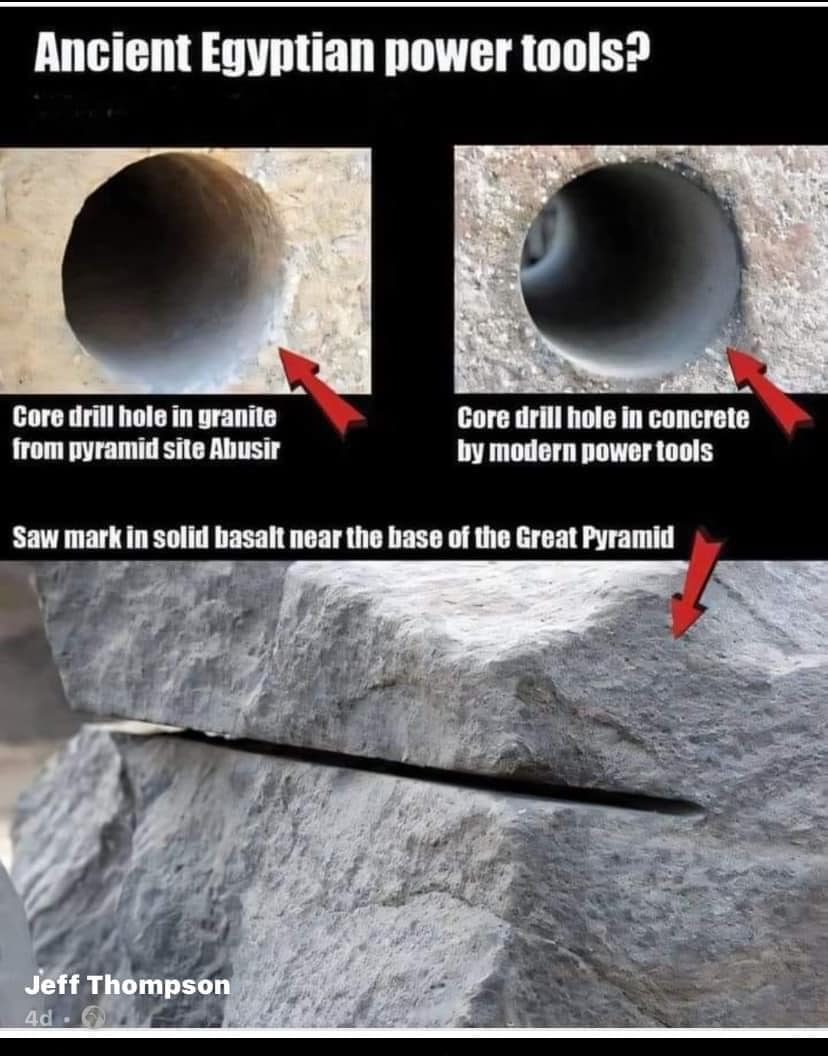this post was submitted on 03 Aug 2024
164 points (98.2% liked)
InsanePeopleFacebook
2486 readers
600 users here now
Screenshots of people being insane on Facebook. Please censor names/pics of end users in screenshots. Please follow the rules of lemmy.world
founded 1 year ago
MODERATORS
you are viewing a single comment's thread
view the rest of the comments
view the rest of the comments

Its basically a copper tube or a lumberjack style copper 'saw' (which does not actually have teeth) + a guy consistently adding sand.
The tube drills were used with a contraption resembling an archery bow somewhat, with the string looped around the tube, such that you could draw the bow back and forth to 'drill'.
There are multiple, detailed, hieroglyph inscribed picture/diagrams showing how this was done, made by people commemorating the construction itself.
Archaeologists have even reconstructed and tested these methods in our time, and big surprise, they work.
Primitive Technology has a great video showing a couple ways string was used to drive tools. Great channel in general for seeing not only old tools, but how each one was experimented on and refined over time.
https://youtu.be/bS4_K5_tHbg?si=y7AnPJU17DPK5kZu
Don't forget near unlimited manual labor. Don't need power when you can just toss more slaves at the problem.
First part is true, lots and LOTs of people.
The second part does not seem to be true though.
IIRC, the current mainstream idea is that when huge amounts of bulk labor were needed, this was not actually slave labor.
Basically, the common farmers would take a seasonal break from working the land and basically all be sort of conscripted into this bulk manual labor, for which they were housed and fed and I think even paid a bit, with the funding for all this coming out of the taxes they paid from their agricultural produce.
Also, a good deal of the more specialized engineering and stone masonry work was done by craftsmen, who were paid a wage.
Note that when I say things like wage and tax, often this was done not in monetary terms, but with payment in widely tradeable, widely valuable goods like grain or cattle or pottery.
Coined money did not become prevalent until fairly far into the total history of ancient Egypt.
There were servants and slaves of various kinds, but the maximum proportion of the population that were slaves was probably around 10%, and that is in the Middle Kingdom, not the Old Kingdom when most of the great architectural marvels were built.
The majority of labor provided to ancient Egyptian grand works were done by peasants who were compensated, and likely would have viewed being able to partake in such projects as a kind of great and holy honor.
I think the difference between employee and slave is much less than we might think in today's terms.
The workers were there by choice, and they were treated well enough to want to be there, but I don't think most of them were paid a wage.
Per the "fall of civilizations" podcast they were indeed compensated and treated well.
I have not read their sources so I can't confirm, but I have no reason to disbelieve them.
I too am a fan of fall of civilisations!
What does "compensated well" mean in this context though? There was no currency with which to pay. I thought compensation was mostly food, beer, and lodging.
In an age of no currency existing, what other pay would have been good compensation in your mind?
Land or livestock.
Good point there, I forgot livestock was a thing.
Ehh, "Slaves did it" is still still more accurate than "aliens did it" if you judge it on a sliding scale.
Do you have a source for this? I have long speculated that the pyramids were a massive make-work program, I just never bought the idea that there were just tons of slaves doing that work. Obviously Ancient Egypt was a slave society, but where did all of the slaves come from? If Egyptians like enslaved an army or like another city that was so massive that they needed to find extra work for them, building megalithic structures, etc., how do they make sure the slaves don't revolt? They would need many more slave masters, more slave catchers, etc., and where do those people come from? The political economy of Pyramids being built by slaves doesn't add up. They must have been excess labor. I'm no expert but the back of the napkin math always seemed really fishy to me.
Edit: oh I see the "fall of civilizations recommendation further down, I'll check it out
Once again, the instructions were all there.. we just needed to RTFM